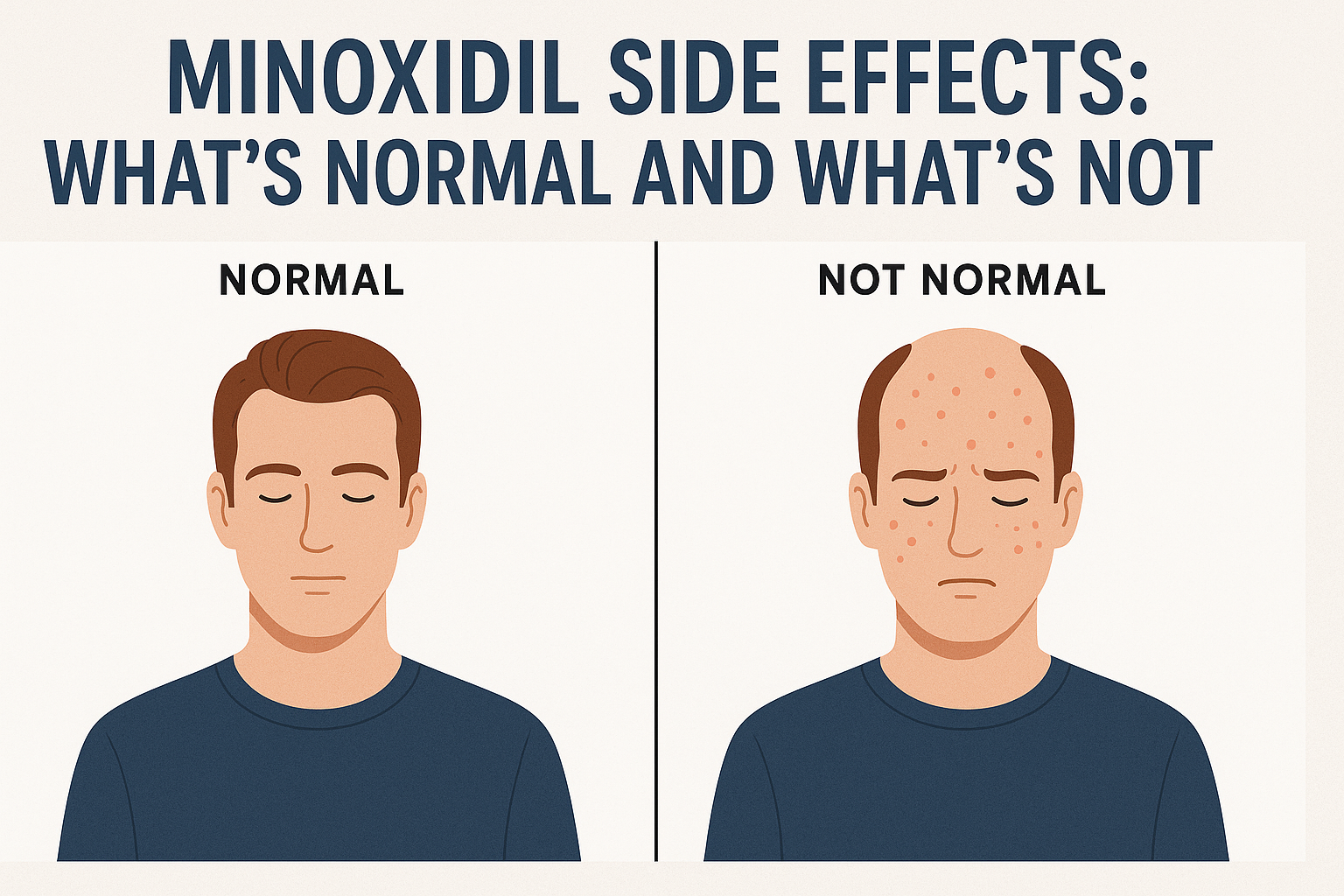Minoxidil Side Effects: What’s Normal and What’s Not
19th Oct 2025
 Minoxidil is one of the most widely used treatments for hair loss — and for good reason. It’s been approved by the FDA for decades, and millions use it daily to help regrow thinning hair. But like any treatment, minoxidil can cause side effects.
Minoxidil is one of the most widely used treatments for hair loss — and for good reason. It’s been approved by the FDA for decades, and millions use it daily to help regrow thinning hair. But like any treatment, minoxidil can cause side effects.
In this article, we break down what’s expected, what’s common, and what might signal a problem. Whether you're just starting or you've been using minoxidil for months, it's important to know what your scalp is trying to tell you.
What Is Minoxidil?
Minoxidil is a topical solution used to stimulate hair growth and slow down hair loss. It works by widening blood vessels in the scalp, improving blood flow to hair follicles. You’ll find it in products like Rogaine and high-strength formulas like those at Xandrox.
It’s available in 2% and 5% strengths, and higher concentrations can be prescribed or customized.
Learn more about how topical treatments work in our guide:
? What to Expect from 6 Months of Using Xandrox for Hair Loss
Normal Minoxidil Side Effects
These are common and usually mild — most users experience some of them, especially early on.
1. Shedding in the First Few Weeks
Yes, shedding more hair at the start is normal. This is called "dread shed" — your older hairs fall out to make room for new ones. It usually starts 2 to 6 weeks after starting minoxidil and lasts a few weeks.
2. Scalp Dryness or Flaking
Many users report a dry or itchy scalp when starting. This is often due to the alcohol or propylene glycol in the formula, not the minoxidil itself.
You can try:
-
Switching to a low-irritation formula
-
Applying a light, non-comedogenic oil to the scalp
-
Reducing how often you apply it (check with your provider first)
3. Mild Redness or Tingling
This may happen as your scalp adjusts. As long as it’s mild and short-term, it’s usually nothing to worry about.
Less Common Side Effects (Still Usually Harmless)
These side effects are less common but still within the expected range for some users:
1. Unwanted Hair Growth (Face or Neck)
Some people report hair growing on the forehead, cheeks, or neck. This often happens if the solution drips or transfers during application.
Tips:
-
Apply with care and wash your hands right after
-
Don’t lie down immediately after use
-
Avoid applying near the hairline or temples if not needed
2. Headaches or Lightheadedness
Because minoxidil was originally used for blood pressure, a few users may feel slightly lightheaded. This is more common with high-strength solutions or if applied too often.
If symptoms continue, speak with a doctor and consider a lower dose.
Side Effects That Are Not Normal
Some symptoms may mean minoxidil isn’t right for you or needs to be adjusted. Stop use and speak to a healthcare provider if you experience:
1. Chest Pain or Rapid Heartbeat
These could point to a systemic reaction and need medical attention. It’s rare, but it can happen — especially with oral minoxidil or if the topical dose is too high.
2. Severe Itching, Rash, or Burning
A strong allergic reaction is uncommon but possible. This could be a response to propylene glycol, not the minoxidil. In this case, ask your provider about propylene glycol-free formulas.
3. Swelling of Hands, Feet, or Face
If you notice swelling, stop use and speak with a doctor. This may be a sign of fluid retention.
Tips to Reduce Side Effects
-
Use only the amount directed — more isn’t better
-
Apply to dry scalp only
-
Don’t mix with other products unless advised
-
Try a formula tailored to your skin type — like those from Xandrox
When to Talk to a Specialist
If side effects bother you or get worse, don’t guess. Speak to a doctor or hair loss specialist. You can also contact Xandrox to ask about custom formulas or ingredient adjustments.
Related Reading on Xandrox.com
Frequently Asked Questions (FAQ)
Is shedding after starting minoxidil normal?
Yes. Shedding in the first few weeks is common. It means older hairs are being pushed out to make way for new growth.
Can I use minoxidil on a sensitive scalp?
Yes, but choose a gentle formula. If irritation happens, look for versions without propylene glycol.
How long do minoxidil side effects last?
Most side effects go away within a few weeks. If they continue or get worse, talk to a specialist.
What if minoxidil causes chest pain?
Stop using it and seek medical help. This is a rare but serious side effect.
Can I lower the dose if I get side effects?
Yes, but always check with your healthcare provider before changing your dose or frequency.
Final Thoughts
Minoxidil is a proven treatment for hair loss, but like any product, it can cause side effects. The good news? Most are mild and temporary. If you know what to expect, you can manage them with care — and stick to your plan for long-term results.
Looking for a solution that fits your needs and scalp sensitivity? Explore the Xandrox range of topical treatments or contact us for help choosing the right formula.
